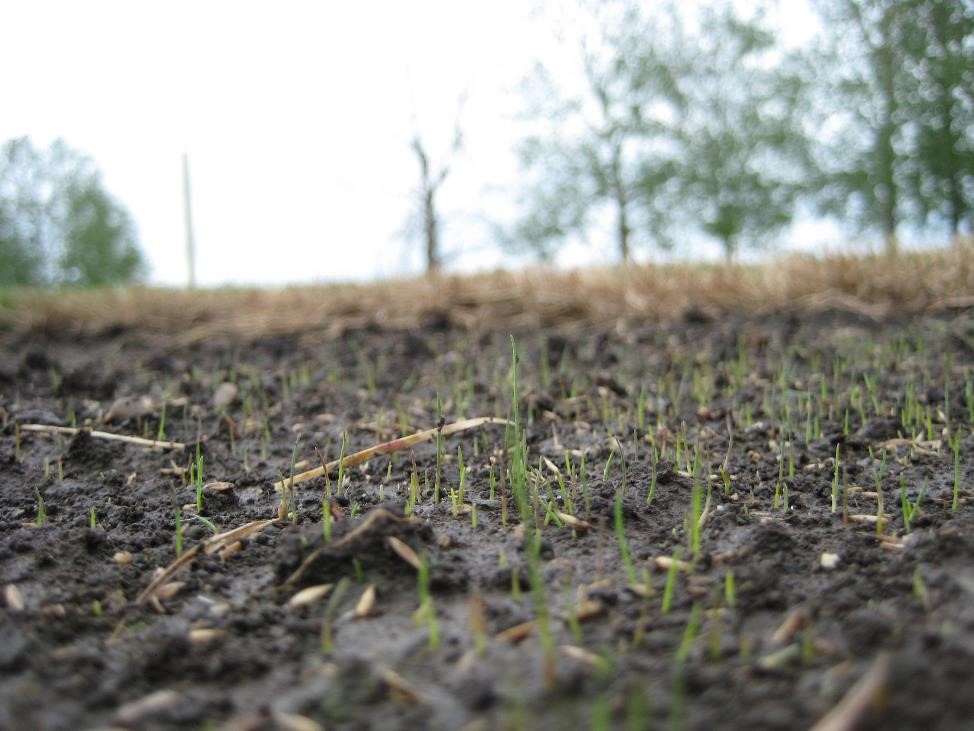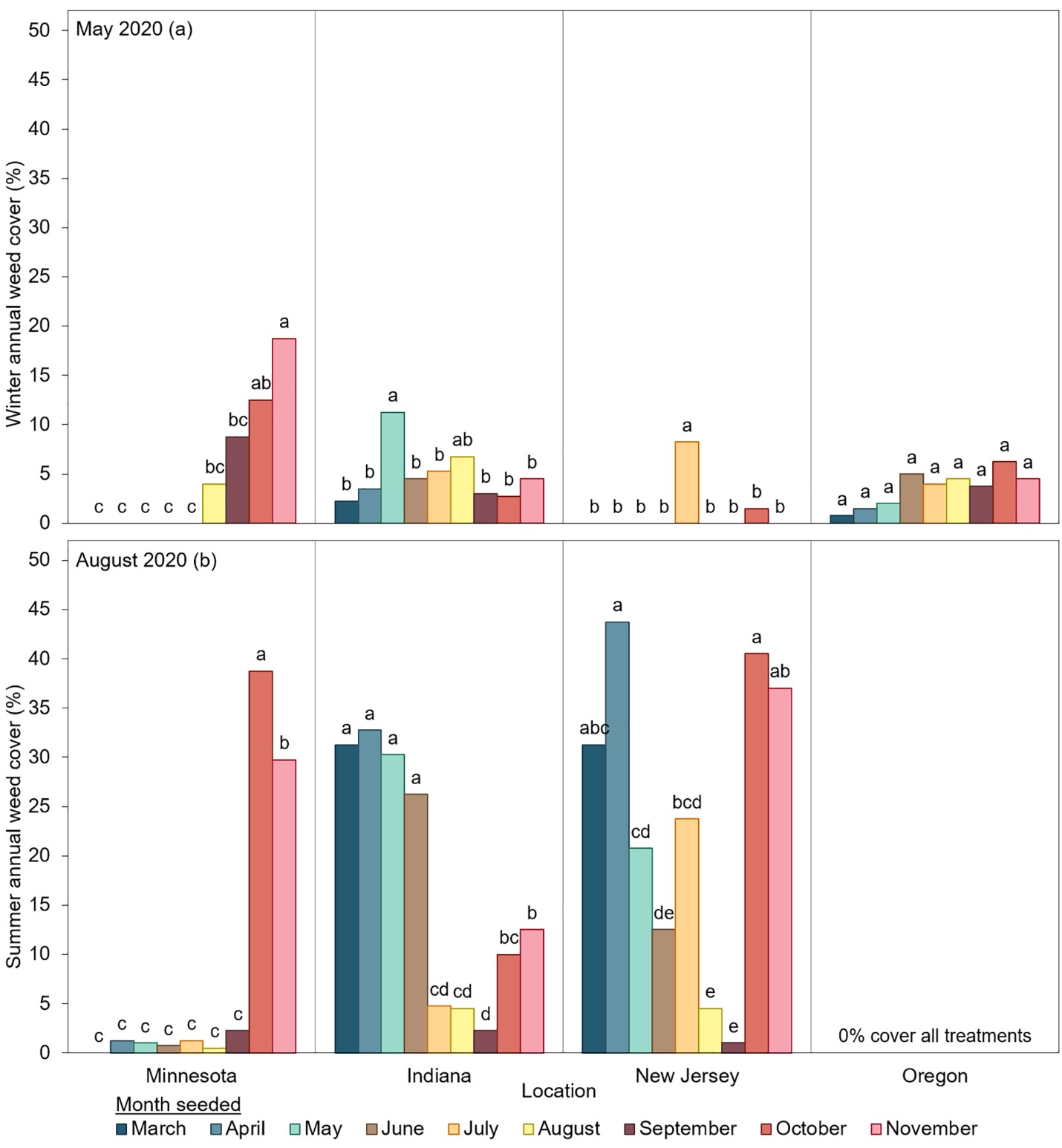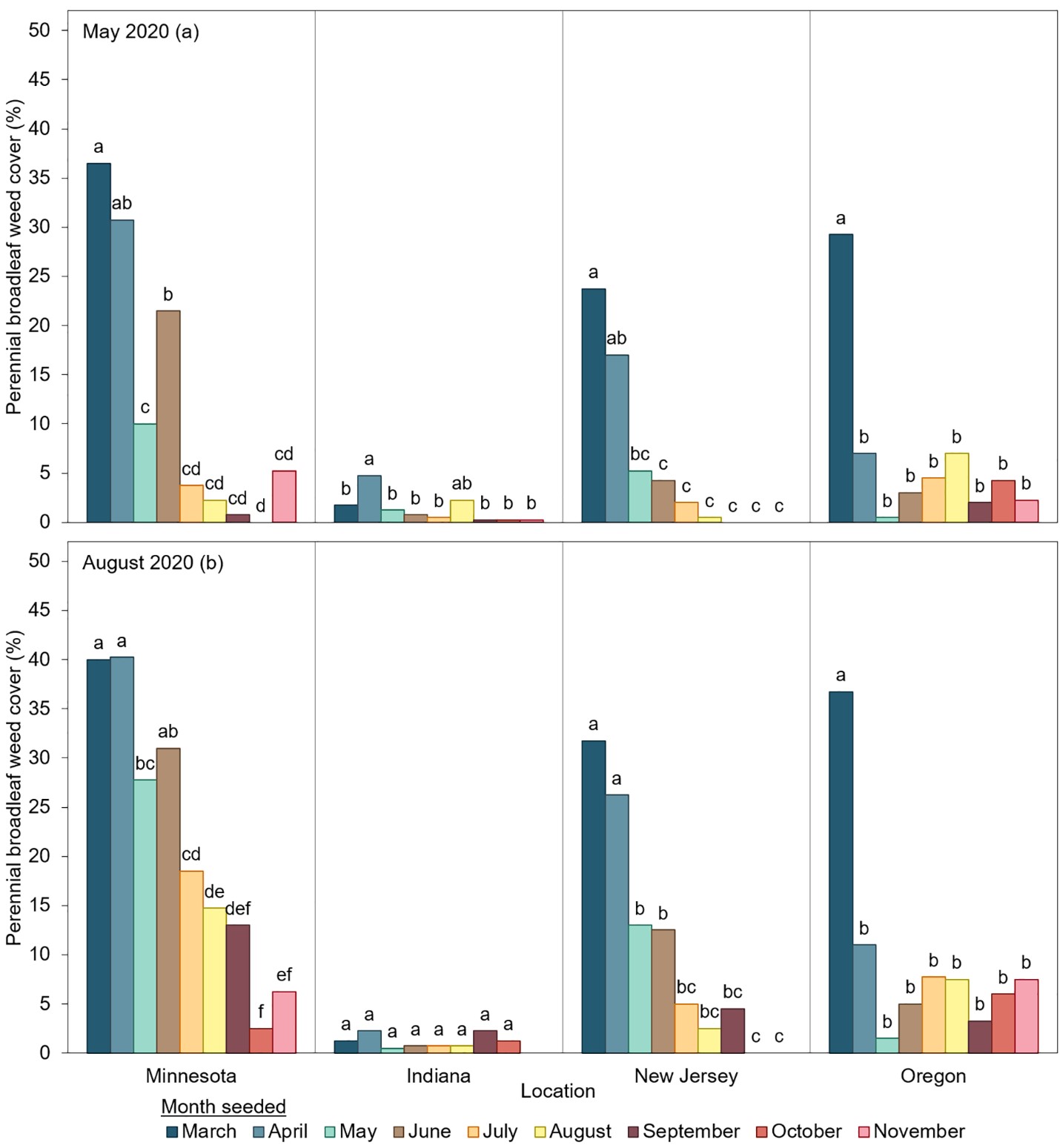By Ross Braun and Aaron Patton, Purdue University
In the blog post last month (November 2021), Emily Braithwaite and Dr. Alec Kowalewski, Oregon State University summarized the findings and how a recent experiment was conducted to investigate optimal seeding dates for fine fescues across four U.S. locations (Oregon, Indiana, Minnesota, and New Jersey; Figure 1). In summary, seeding a fine fescue mixture in August and September provided the best establishment with the lowest weed pressure across all four locations. However, the Mediterranean climate of Oregon allowed for more flexibility in fine fescue seeding timing with more success for all the months of May through September.
What caused the other monthly seeding timings in early or late spring, summer, or late fall at the other northern U.S. locations (Minnesota, New Jersey, and Indiana) to not perform as well? In this blog post, we will dive a little deeper into the challenges you may face when seeding fine fescues at less than optimal times of the year.
Early spring (March-April)
Lower air/soil temperatures during the early-spring seedings resulted in slower germination and establishment rates for the fine fescue seed mixture. This meant after tilling and disturbing the soil to seed in early spring, the fine fescue turf not only was slower to fill in bare spots, but also allowed for easier infestation of weeds, especially perennial or summer annual weeds heading into summer (Figures 2 and 3).
Late spring to early summer (May-June)
Air and soil temperatures were optimal for fine fescue seed germination and emergence during the late spring to early summer; however, this means temperatures were also optimal for summer annual grassy weeds (crabgrass and goosegrass) at this time (Figure 2). Disturbing the soil via tilling and then seeding created an ideal opportunity for summer annual weeds to germinate alongside the desired fine fescue seed. This resulted in a battle for space between summer annual grassy weeds and fine fescues for the rest of the summer until cooler temperatures and a hard frost occurred in autumn. After the hard frost, we observed the fine fescue turf cover to increase and outcompete the summer annual grassy weeds, which had completed their lifecycles. Regardless, the May and June seeding timings still tended to have more summer annual weeds the following year, but this can generally be remedied with a preemergence herbicide in the spring of the following year after fine fescue seeding.
Late summer to early autumn (Mid-July through September)
In August and September, and at times July, the high air and soil temperatures led to fast germination, emergence, and overall establishment of the fine fescue seed mixtures. The optimal growing conditions with cooler night temperatures than summer and less weed pressure typically observed in mid-August through September led to fast establishment rates and minimal weed competition.
Late autumn (October-November)
Soil temperatures may still be warm enough for fast germination and emergence of fine fescue in October, but days with optimum growing temperatures to allow the fine fescue to spread and fill in are usually limited. Fall temperatures at the research sites, except Minnesota, allowed for the fine fescue mixture seed to germinate and emerge in October, but growth and further establishment to fill in the area was limited due to the onset of colder temperatures by late October and onward. The cold Minnesota climate with air and soil temperatures <50 °F caused the October seeding timing at this location to function as a “dormant seeding” (i.e., germinate in the spring upon the return of warmer temperatures). Except for Oregon, the low November air and soil temperatures (<44 °F) also acted as a dormant seeding resulting in seedling emergence in late winter or early spring in the remaining locations. One of the risks with tilling the soil and dormant seeding a turf area is the desired turf seed, once it germinates the following spring, may have to compete with present winter annual weeds that germinated during late autumn through winter or summer annual weeds germinating the following spring (Figures 2 and 3). Dormant seeding can be successful practice to overseed thin lawns or repair spots in your lawns, but there are risks, see the following for more information: Establishing Turfgrass Areas From Seed and Dormant Seeding.
Summary
Research on optimal seeding dates has shown that the best time of year to seed fine fescues is between late July and late September and there is more flexibility in seeding timings in Mediterranean climates, such as Oregon. Seeding in early spring between mid-March and mid-April has the potential to work, but there may be increased weed pressure and greater variability in success. Non-optimal seeding dates, such as late spring (May) or summer (June/July) will subject the young turfgrass to harsh environmental (heat and drought) stresses and increased weed competition from summer annual weeds. Also, seeding too early in the spring or too late in the fall may fail due to unfavorable (i.e., too cold) growing conditions and/or not enough time for the young turf to fully mature before winter, during which newly seeded turfgrasses exhibit a very slow or imperceptible establishment rate.
The full manuscript of this experiment is open access (free) available in Agronomy Journal (https://doi.org/10.1002/agj2.20859).
References
Braun, R. C., Patton, A. J., Watkins, E., Hollman, A. B., Murphy, J. A., Park, B. S., Kowalewski, A. R., & Braithwaite, E. T. (2021). Optimal fine fescue mixture seeding dates in the northern United States. Agronomy Journal, 113, 4413–4428. https://doi.org/10.1002/agj2.20859


